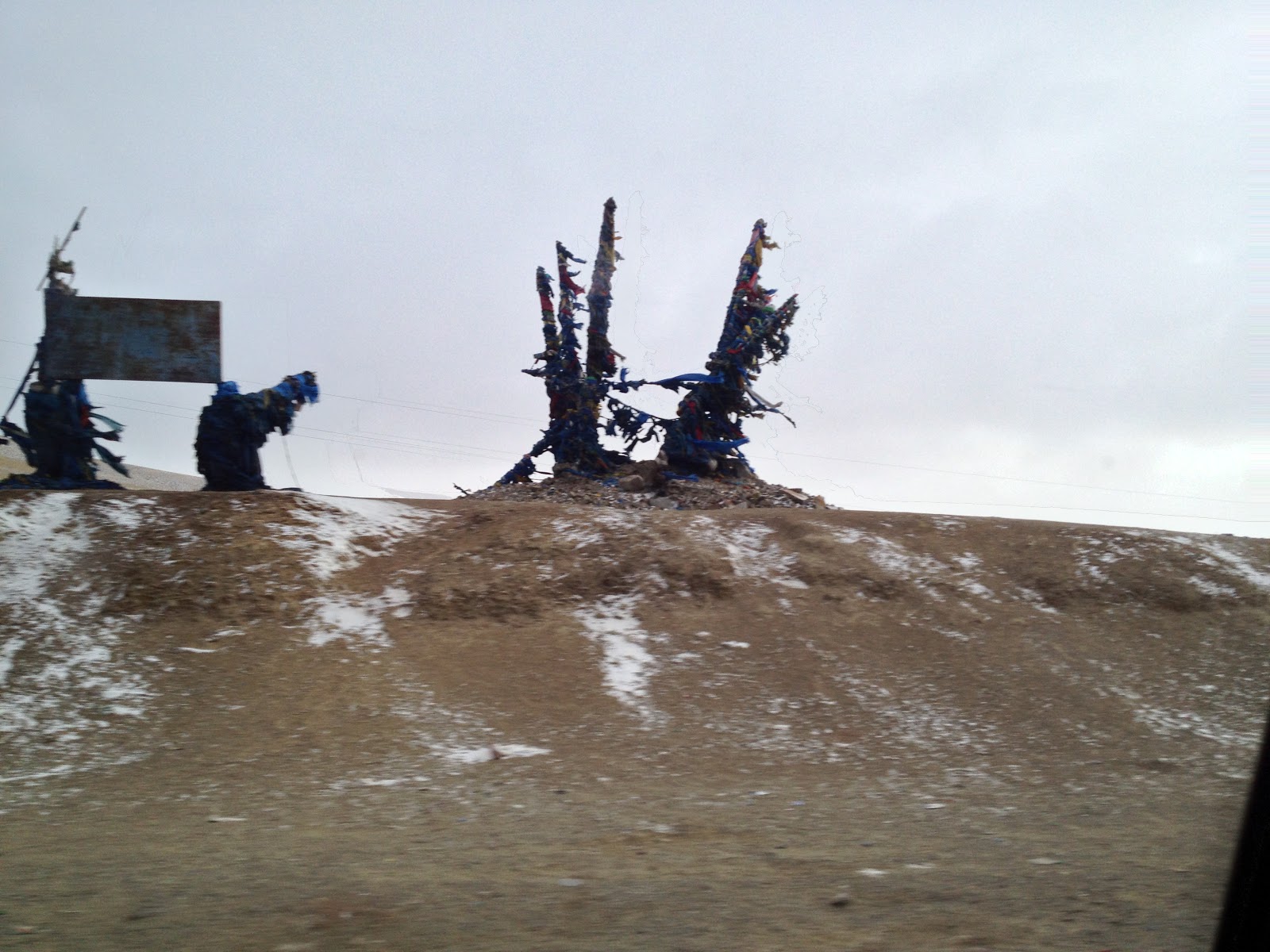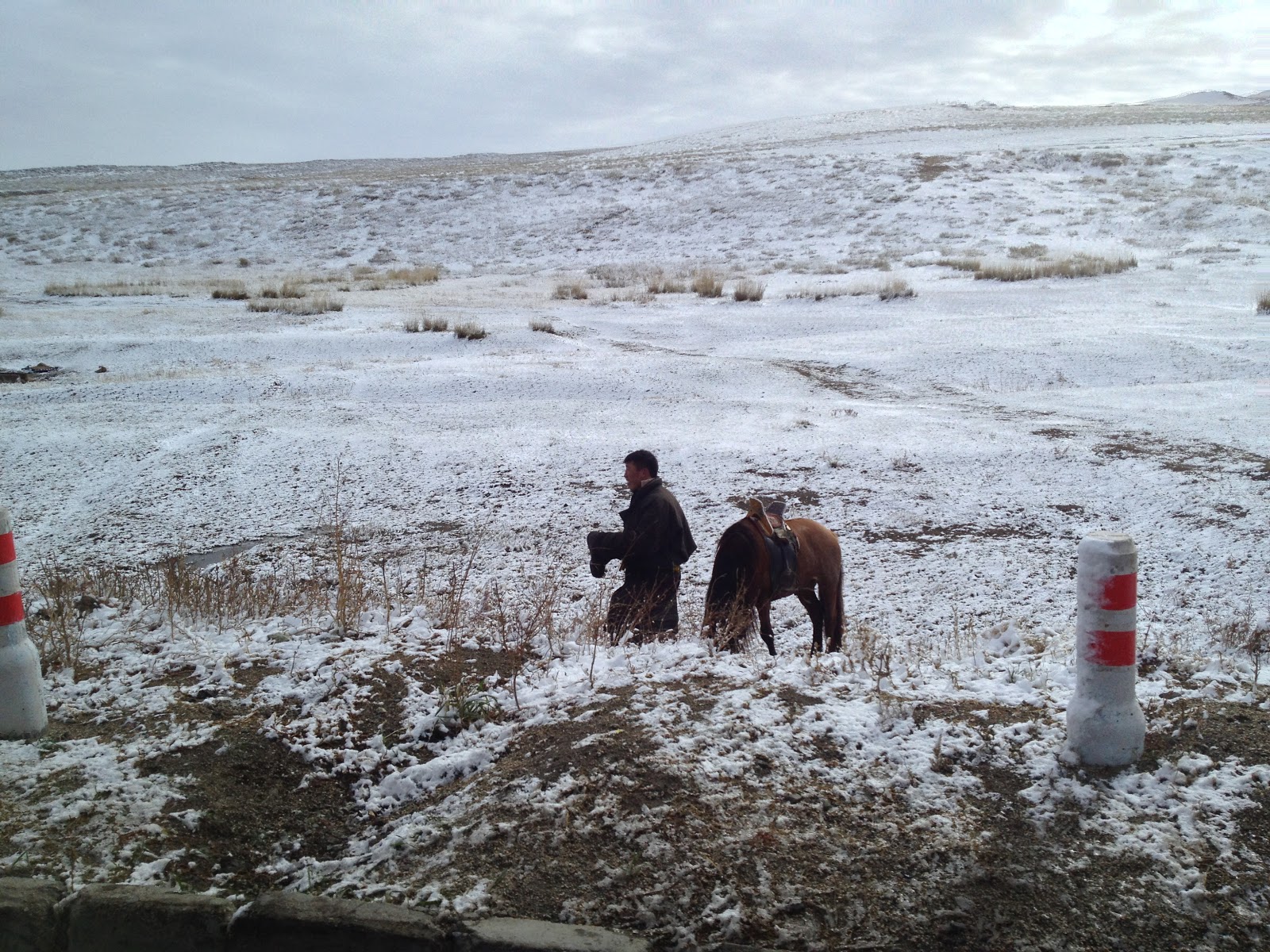We had met our driver, Mr. Tuvshin and our translator Mr. Shagai the day before, briefly. Turns out we had to get into one car for our ride outside of town, and then transfer to another once we reached the outskirts. To reduce traffic, only certain cars are allowed on the roads of UB on certain days. The SUV we were to take wasn't allowed on the streets that day, so they had to drive it out of the city the day before.
We headed out in the car for another mad drive through UB traffic. Trust me when I say this, no matter where you have driven, there is no place that will prepare you for driving (or in our case even riding) in UB traffic. We began to get to know Mr. T and Mr S. better as we traveled north. Liz and I were busy snapping pictures while we talked. Now think in your head of a poorly paved road near you. Add some more potholes, make it straighter, and add huge washouts at various places - like swallow a smartcar type potholes/washouts. Now sit in the back seat of the car as it does anywhere from 55-95 mph (yes, mph, not kph) down the road. But the scenery was amazing.
 |
| The native herder's Gers. They are the traditional nomadic herders, and make up roughly 1/2 of the country's population. |
 |
| Much of the view on the way north |
 |
| At many places along the way there were Buddhist Religious Shrines. |
 |
| These were happily crazing on the side of the road. Others had no issues just stepping into the road though. |
 |
| Most of the animals were tended by herders, either on horseback, foot or motorbike. |
 |
| We were told this was "Russian Socialist" style housing. In most every town we came to, outside of UB, this was the only housing available, all built in the 1950's-1980's, most crumbling. |

 |
| A coal fired grain dryer at Gatsuur |
We got in the car for our first set of opposites of the day. We traveled roughly 90km on bouncy dirt roads until we came to a large gate on the left side of the road. We were met outside the gate, and the guard opened it. We were entering the largest farm in the country, one of 6 owned by the Gatsuur company, a 100% owned Mongolian congolmerate with interests in gold mining, hotels, farming and more. While the company farms 125,000 acres, this farm alone (as I mentioned the largest in all of Mongolia) was roughly 65,000 acres with half that planted to wheat, potatoes and other vegetables. Roughly 15,000 acres are irrigated, and on the non cropland, they free-range 6,000 cattle, 5,000 sheep, and 300 horses. The crop operation rivaled anything you would find in the US - computerized grain storage, movement and drying, all top of the line planters, tilling equipment and combines, all green, and all John Deeres. When asked how many combines they used for the harvest the manager of the farm, a young women in what appeared to be her late 30's responded that while they have 30, they were only able to run 24 this harvest as they lacked good operators. While I didn't catch the model,each combine was capable of harvesting about 170 acres a day.

We next moved on to the farm's animal husbandry side of the operation, starting with the farmer's slaughterhouse. It employs roughly 20 people, and can slaughter up to 100 cows, or 200 sheep or goats in an 8 hour shift. They process all their own animals on the farm, selling most as dry aged carcasses. They have recently added a butchering facility that processes up to 50 tons meat in a day, and are soon to open a sausage processing facility. It was truly impressive. One of their major investments is an attempt to improve their herd. Over the last two years they have imported (by plane) 167 cattle from France.
I want to take a short sideline here to talk about how they raise meat in Mongolia. It is done on grazing lands without fences. A herder tends the flock, and corrals the animals each night. The herder lives in a ger and as the grazing land runs out, moves his home and his herd. The animals are fed no grain, and May-October, graze for 100% of their food. The herder has a winter grazing ground that is kept free from grazing all year, and when possible the herder cuts native grasses for hay and piles it behind and atop a rudimentary shelter of logs and dirt at the winter grazing site. In mid-late October the farmer moves his herd to this area, usually in the shelter of a mountain. The herd grazes for much of its food all winter on this winter grazing ground, and instead of being merely corraled in an open pen at night, is put into the covered shelter each night. The animals diet is supplemented with some of the cut grass when the weather is the worst, but this is minimal. From October-December the animals are slaughtered, while they still have summer fat. Breeding is done naturally within the herd, the bulls, rams, or bucks always being in the herd. Its a bit different than what we do in US that is for sure.
 |
| A small part of the 1,000 goats that the nomadic herding family raised for cashmere. The herder was very proud that the herd produced, on average, roughly 400 grams of cashmere per animal. |
After finishing up our tour, we were invited back to the farm's cafeteria - the farm's 120 employees all live on the farm in a large hotel/apartment complex. We were served a dinner of meatloaf, potatoes and rice (with only the rice not having been grown in the farm). It was now just getting dark and we had one more stop to make. We got back into the vehicle, drove back out the gate, crossed the dirt road, and took off across several kms of open pastures until we arrived at a ger (or as we call them in the US, a yurt.)

After a short introduction we went inside and proceeded to go through several rituals. First we had to get the seating correct - me on the right, Liz on the left. I then accepted a sniff of snuff (no, not any of the hard stuff just tobacco) and a bowl of milk wine. They ferment milk, and then boil off the alcohol capturing it through a distilling process. Oddly enough while it had a dairy taste, it tasted more like sake than anything else. Liz and I each were instructed ahead of time that while it was fine to politely refuse, or just sip subsequent offerings, the first bowl/cup must be fully consumed. They were not small. Next came the vodka (made in Mongolia from wheat, actually one of the best Liz and I had ever had) and the dinner. And yes, this would be our second dinner by 8:00, after having lunch around 1:00. The pictures here tell the story of the meal - an entire lamb that is layered in an aluminum container with alternating layers of meat and hot stones and some vegetables.
The ger was amazing. While it was bitter cold (windy and well below freezing outside) it was toasty warm inside with only a small stove fueled with dung to provide the heat. There was a car battery with a solar panel, single florescent bulb, and a tv. Did I mention the small Direct TV style dish out front? What Liz and I both found the most amazing was were the topic quickly steered - who did we like in the US election; what did we think of Mitt Romney; of President Obama; and when we got back, we were to tell everyone that all of Mongolia was supporting Barack Obama. Here I was naively thinking I had escaped the campaign season back home, and yet the most fervent campaigning I have been subject to all year was in a ger on the plains of the Selenge river, by a group of nomadic herders who really cared about who our next president would be.
After some very heartfelt thanking, we climbed back in the vehicle for our trip back to the Suhbaatar and our beds. The next day was all play, but just as amazing, but it is late and I must save that for my next post. As a teaser - based on the connections in the governor's office we got to stand one foot in Russia, one in Mongolia and never even show our passports!

No comments:
Post a Comment